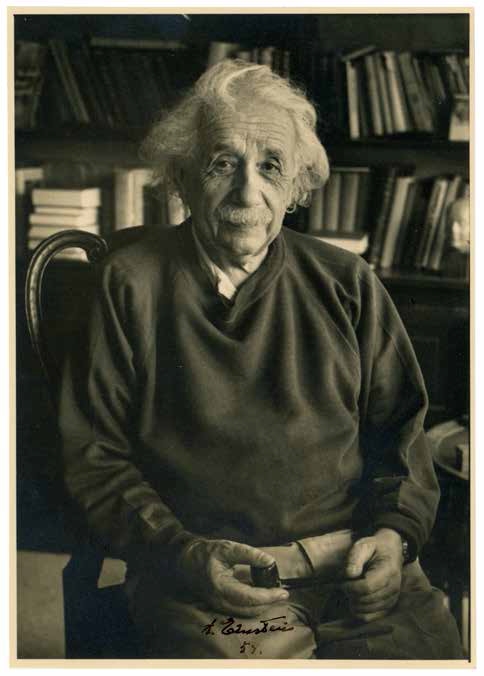
Einstein photograph signed and dated 1955
Image reproduced from EINSTEIN: THE MAN AND HIS MIND, page 193.
“For us physicists, the distinction between past, present, and future is only a stubbornly persistent illusion.” Albert Einstein, 1955.
One month preceding his own death, Albert Einstein wrote these words in a condolence letter upon the death of his best friend Michele Besso. What did he mean by them?Einstein’s remark doesn’t suggest that time isn’t real. But his words convey that our perception of time as a constant, flowing entity does not accurately reflect its actual nature.
As an analogy, consider the everyday perception that the sun rises in the east and sets in the west when, in fact, the earth is rotating instead of the sun moving across the sky. Our self-centric perspective leads to a discrepancy between perception and reality.
The perception of the sun’s movement is relative to our position on the earth’s surface. An observer on the moon, for example, would have a very different experience of the earth’s rotation and the sun’s motion. Understanding that the sun’s apparent movement across the sky is an illusion requires a conceptual shift from an earth-centered to a sun-centered model of the solar system. Similarly, the experience of time’s flow is relative to the observer. Observers moving at different velocities or in different gravitational fields experience time differently, as indicated by time dilation in special and general relativity.
The explanation for the sunrise-sunset illusion is simple to demonstrate and understand. Observing the earth’s rotation or modeling the solar system clarifies the phenomenon. The illusion of time’s flow is more abstract. It’s not just a physical phenomenon but also involves how our brains process temporal information.
If Einstein’s theory of relativity is correct, it is not time that is passing. Rather, we are passing through spacetime. Accepting that the flow of time might be an illusion requires a shift from a presentist view where only the present is real to a “block universe” view where all points in time are real.
The prevailing view of time before Einstein was based on the classical mechanics formulated by Isaac Newton. In Newtonian physics, time is absolute and universal, ticking at the same rate for everyone, everywhere. This view treats time as a separate entity from space, an unchanging backdrop against which events occur.
Einstein’s theory of special relativity, published in 1905, fundamentally altered our understanding of time. A key aspect of special relativity is the relativity of simultaneity. Events that are simultaneous to one observer will not be simultaneous to another observer moving at a different velocity. This idea was revolutionary because it implied that there is no universal present moment that all observers can agree on. Instead, each observer has their own slice of time, or “now,” which may differ from others.
Einstein’s insights led to the concept of spacetime—a four-dimensional continuum that fuses the three dimensions of space with the dimension of time. Events are described not by their location in space alone but by their position in spacetime. In this theoretical framework, time does not “flow” as we perceive it; instead, all moments in time are equally real and existent. The steady passage of time is thus an illusion, a byproduct of our conscious experience.
Implications
The relativity of time conflicts with our everyday experience and intuition.
The perception of time passing is a product of how our brains process temporal information. Neuroscientific studies suggest that the brain constructs the experience of the present by integrating sensory inputs over a short duration, which may create the illusion of a flowing time. In a block universe, each moment is static where the future is as real and existent as the present and past. It is a deterministic universe, which is difficult to reconcile with the concept of free will.
The concept of time as a fourth physical dimension also raises the question of whether time travel is possible. In theory, traveling to the past or future might be possible if all points in spacetime exist. However, practical mechanisms for time travel remain speculative and face numerous paradoxes.
Summary
Einstein’s phrase, “the distinction between past, present, and future is only a stubbornly persistent illusion,” stems from the revolutionary concepts he introduced in his theories of relativity. Special relativity showed that time is relative to an observer’s velocity, and general relativity demonstrated that gravity affects time. These theories suggest a block universe where past, present, and future coexist, contradicitng our everyday perception of time as a steadily flowing entity.
Learn more about EINSTEIN: The Man And His Mind.
